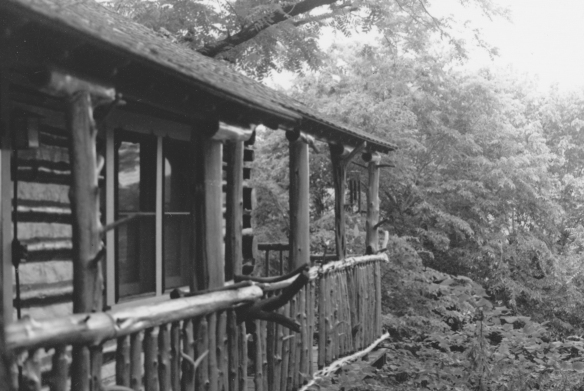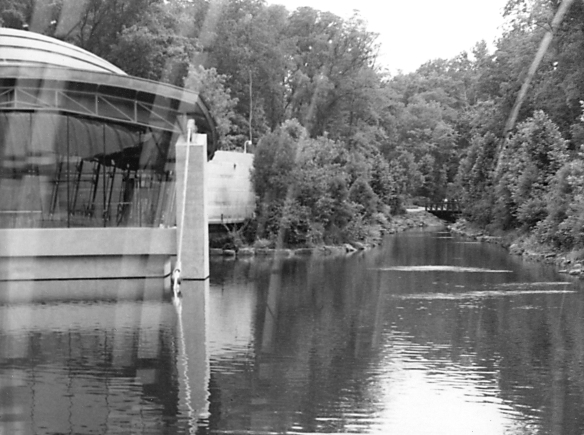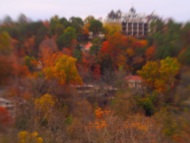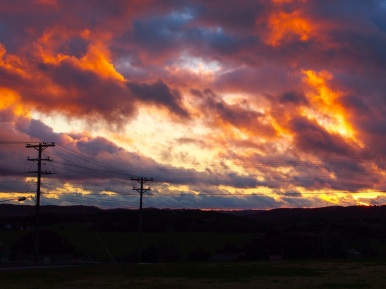I am attempting to shoot a roll of film a month this year – I’m about a month behind, but I’m catching up. My niece, Laura, came for a visit at the end of June. She is an avid shutterbug and has been interested in learning to operate a film camera. She picked up a Pentax kit and brought it with her on her trip. Once we got the pieces out and looked them over I found that my mother’s Vivitar Cosina from the late 70s was also a Pentax mount. Score! I was able to add a doubler, a fast 50, and a telephoto to her kit. More importantly, I was able to hook her up with a very cool vintage strap…

Couple of shutterbugs – Jasper, Arkansas
In preparation for her visit I had purchased us each a roll of T-Max 400 and a roll of 100 speed film. We covered the basics and she was off and shooting in no time. I started with the 400 – that’s what this roll is. Having Laura here got me out and about, so most of these shots are taken away from the house and I shot very few still lives. I actually only had a couple of chances to shoot indoors at all. I shot exclusively with the 50mm 1.4. This gave me a very shallow DOF, but also allowed some areas of sky to blow out.
Shooting outdoors I had a chance to play with sunlight – sometimes with better results than others. I’m finding that instead of seeking out high contrast subjects, that I need to make sure a black and white image has lots of mid tones.

Backlit Sunflower – Historic District – Eureka Springs, Arkansas
While the shot above shot worked exactly as I imagined it – the next shot I’m not completely sold on – I like the bokeh and the light on the leaves – even the sunspots, but I wish I had more detail in the sky.

Soaking up the Sun – Historic District – Eureka Springs, Arkansas
There is a spot I love to shoot – I’ve never really mastered it but I know that someday I will get the shot I’m imagining there. It’s an underground grotto that surrounds a natural spring. I want to get a shot from inside the grotto in the fall capturing all the color in the distant hills – these are not those shots, but I kind of like them. The feel historic to me.

The View from Inside the Grotto – Grotto Spring – Eureka Springs, Arkansas
The shot above is from the center of the grotto – on most days sunlight overwhelms this view, but the detail before you leave the stairs works fairly well. The blown out sky does give you the sense of sunlight pouring in.

Shooting into the Sunlight at Grotto Spring – Eureka Springs, Arkansas
Next I tried an angle – it lets the texture of the limestone stairwell come alive, this one feels more like the experience of being underground and looking up into the light.
While I was inside the grotto, a small circle on the ground caught my eye – it’s a perfectly round hole in the surface of the limestone step – a stair railing must have been here at some time…

Rail Base – Grotto Spring – Eureka Springs, Arkansas
The surface of the stone gave me some of those mid tones I have been searching for. The deep shadow and the highlight on the water give me the full tonal range I have been hoping to achieve with my black and whites.
I have been reading a lot about leading lines in hopes of improving my landscape skills – this historic bridge gave me some lines to work with…

The Beaver “Golden Gate” Bridge – Beaver, Arkansas
This is the Ozarks very own “Golden Gate” bridge – the towers are actually painted yellow – it’s a one-lane bridge so you have to take turns crossing it. I have shot it many times in color and have a photo by a local artist in my home – I resisted the temptation to shoot it straight on and vertical – I see that done a lot here. For the second view I decided to make the diagonally striped sign the focal point – I have never known what that sign means…

Diagonal Stripes – Beaver Bridge – Beaver, Arkansas
The “fast fifty” lens lets me get sweet details in the foreground, like the bolts to the right of the signs – and lets the details in the distance soften.
Shooting the manual camera has been a challenge – you need longer exposures in many cases to capture detail, but it is very difficult to keep the camera still enough. In college I shot my moms Vivitar Cosina – the one I gave Laura. It has an Auto setting that is basically a primitive Aperture Mode. You set the aperture and the light meter tells you the shutter speed. I would adjust the aperture until the shutter speed was about 125. The Olympus is completely manual with a built-in light meter. You have to adjust both the shutter and the aperture until you get the needle centered on the light meter. In some cases there is just no room to shoot at 125 – there isn’t enough light.

Solar Lanterns – Sweet Spring – Eureka Springs, Arkansas
More good mid tones – I shot this with the aperture close mid way down – this let me capture details in the balloons and in the limestone behind them – it was bright enough to still get a decent shutter speed at about f/11.

Laura Focusing her Pentax – Eureka Springs, Arkansas
This shot of Laura was taken with the aperture wide open – I focused on her camera. The DOF is very shallow. I love the bokeh created by the picket fence behind her.

Lavender flowers at Sweet Spring – Eureka Springs, Arkansas
I used the same setting to capture these flowers, Laura was actually shooting these when I was shooting her.

Log Cabin with Cedar Log Rails – Eureka Springs, Arkansas
This log cabin is on Spring Street in Eureka Springs. It hangs out over a hollow in the middle of town. There are trees near the sidewalk, so you have to find a way to peek through them to get a shot of it with the hollow visible. My first instinct was to shoot it straight on from the street – but I thought about the leading lines and decided to get a view at an angle.

Crystal Spring Seen Through a Curved Window – Crystal Bridges – Bentonville, Arkansas
Now for something a bit more modern – this is a view of the Spring at Crystal Bridges Museum – through a curved glass window. I was curious to see how the curved reflections would play on the image. I close the aperture down to about f/11 in this shot – the DOF is pretty deep.

Brushes at the Norberta Philbert Gallery – Bentonville, Arkansas
When I had a chance to shoot still life, I tried to shoot with the aperture wide open – aiming for a very shallow DOF.

Steampunk Balloons by Tangled Metal – Norberta Philbrook Gallery – Bentonville, Arkansas
I loved these – I also like the shallow DOF – but think I could have closed the aperture down a stop. A local artist creates these from repurposed lightbulbs and clock parts. I shot several of these shots at a great gallery in Bentonville Arkansas located very close to Crystal Bridges.

Rademacher Leaf Vase – Norberta Philbrook Gallery – Bentonville, Arkansas
This vase is by a local artist – he fires pieces with leaves pressed into the clay – I have one of his bird feeders and love the look of it.

Rockwell’s Rosie – Crystal Bridges – Bentonville, Arkansas
I can’t go to Bentonville without checking in with Rosie – my goal with this shot was to capture a bit of the sheen of the paint on the canvas – it’s subtle but it’s there. It’s very interesting to look at something known for its color in black and white.

Newspaper Machines – Jasper, Arkansas
These old newspaper machines gave me another chance to play with leading lines – the diagonals draw you into the image. I like the surfaces on these – they were a vivid blue.

Kayaks Loaded – The Stone House – Oak Hill, Arkansas
I shot this image of the jeep with the aperture fairly wide – the DOF is shallow enough to isolate the subject, but not so shallow that you lose the depth of the image.
So – my thoughts on this project 5 rolls in? Well, I’m getting more keepers per roll and I’m taking a lot fewer shots of each subject – on this roll I only shot a few subjects more than once. Showing Laura the area kept me moving so I shot lots of variety. I also took my film camera everywhere except kayaking. Having it with me gave me lots of opportunities. I stared the next roll at Crystal Bridges in the gardens – I am anxious to see how those worked out. I’m shooting 100 speed now, so maybe I’ll get some sharper images in the mix.
If you would like to catch up with my project, here are the links for the other posts in the series:
Roll #1
Roll #2
Roll #4
Where is Roll 3? Well, it’s in the trash because I didn’t pay attention to the light meter.


















































































































